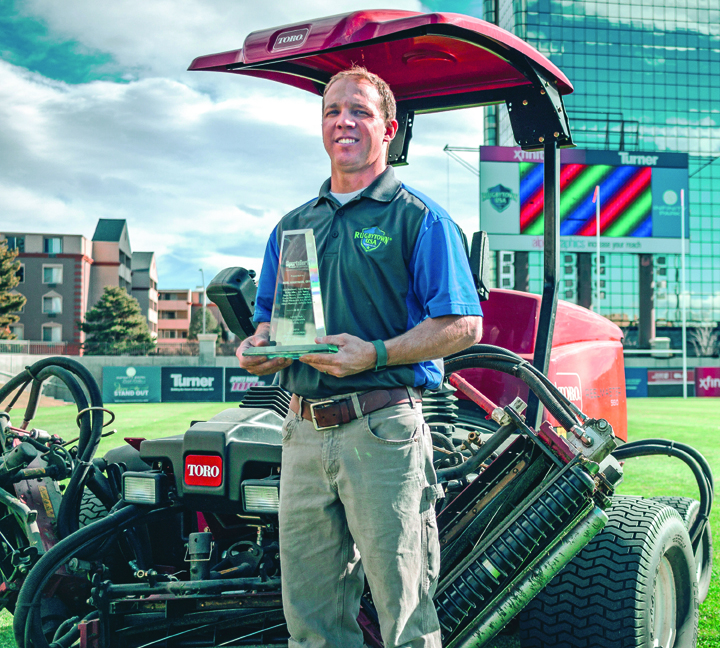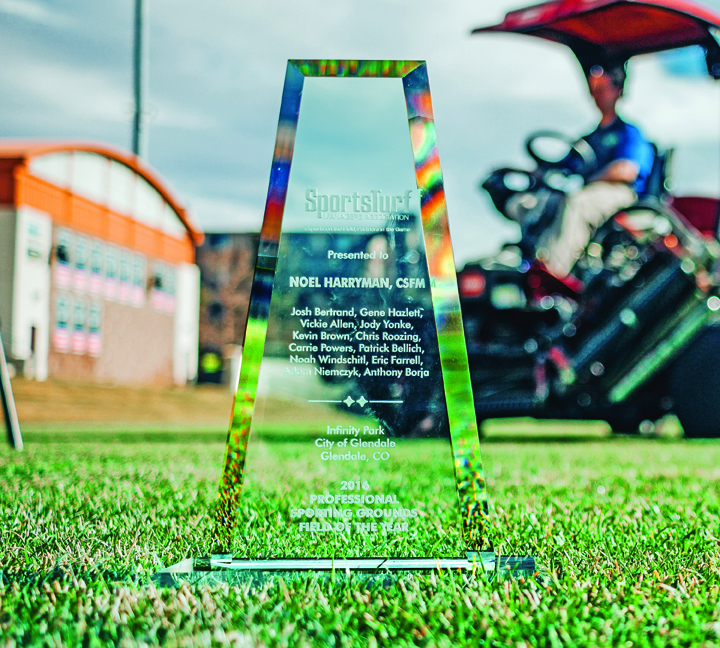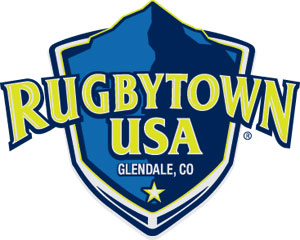by Kurt Woock
Writer for and on behalf of the City of Glendale
 Imagine working all week to make something, only to have someone tear it apart. Now, imagine that happening over and over. That might sound like a punishment suffered by a poor sap from Greek mythology, but Noel Harryman calls it his job. And he likes it. Harryman is the manager for turf operations and Infinity Park. He leads a team from Glendale Public Works who ensure that the more than 10,000 square meters of Kentucky bluegrass at Infinity Park are green, neat, trimmed, and ready to take a beating.
Imagine working all week to make something, only to have someone tear it apart. Now, imagine that happening over and over. That might sound like a punishment suffered by a poor sap from Greek mythology, but Noel Harryman calls it his job. And he likes it. Harryman is the manager for turf operations and Infinity Park. He leads a team from Glendale Public Works who ensure that the more than 10,000 square meters of Kentucky bluegrass at Infinity Park are green, neat, trimmed, and ready to take a beating.
Infinity Park’s rugby pitch is designed to be flexible. It can host private events, it becomes movie theater seating in the summers. But Harryman said his job has one clear central purpose, “My job is to make sure it’s ready for play.” To do that, Harryman combines chemistry, hydrology, botany, and a big dose of sweat equity. And he does it well; Infinity Park won the 2016 Sports Turf Managers Association award for best sporting grounds in the country.
Anyone familiar with the Sisyphean task that is caring f or a lawn knows that the straightforward tasks involved — fertilizing, watering, cutting, weeding — bely a much more complex operation. Having a lush, green lawn is a fixed goal, but the obstacles that stand in the way are, like a game of whack-a-mole, ever changing. Weeds one year, bugs the next. A few months of drought followed by a week of heavy rain. Every year is different. Unlike a homeowner’s yard, however, Harry-man’s proficiency is judged by thousands every week.
or a lawn knows that the straightforward tasks involved — fertilizing, watering, cutting, weeding — bely a much more complex operation. Having a lush, green lawn is a fixed goal, but the obstacles that stand in the way are, like a game of whack-a-mole, ever changing. Weeds one year, bugs the next. A few months of drought followed by a week of heavy rain. Every year is different. Unlike a homeowner’s yard, however, Harry-man’s proficiency is judged by thousands every week.
During the season, Harryman is on the field daily. A week before a game, Harryman and a few others walk every inch of the field. They bring with them a mixture of pre-germinated grass seed, fertilizer, and sand. They look for patches that are wearing thin and apply the pasty mix. The mixture takes hold quickly and will yield grass in a matter of a few weeks. Monday, they give the entire field a full mow and another check for spots that need attention. Depending on the time of year, Monday’s mow might be followed by an application of fertilizer. Tuesday is a practice day, so field maintenance is low, but Harryman must check the field after for any damage done during practice. Wednesday brings another mow.
Thursday the field is prepped for painting. Friday is another mow followed by painting the field, a task that takes three people a full day. Saturday (game day) begins with another spot check for anything abnormal. On a good day, this might be a quick task. But a surprise snowstorm might necessitate an all-hands-on-deck snow removal (something that happened multiple times last year). After the game, the crew fills divots, and mixes a new batch of pre-germinated grass seed, and the cycle begins anew.
A few differences between home lawn care and rugby lawn care emerge. First, there’s a lot of mowing. Three mowings a week keep the lawn uniform. Harryman said that a standard home lawn has a height of 2.5 to 3 inches while Infinity Park’s field is a trim 1.25 inches. The shorter height provides a better playing surface for players and can increase the density of the grass over time.
Harryman also waters the turf using a method more precise than a sprinkler on an automatic timer. He calculates the field’s precise water needs based on temperature, soil measurements, and other variables. He aims to have the soil about 80-percent saturated with water, enough to ensure the plant receives the water it needs while leaving enough absorption potential in the event of rain (or snow). “One of the worst things you can do is play on a wet field,” he said.
Another benefit to not fully saturating the field is to encourage individual grass roots to drive down deeper, which makes the entire field stronger and more resilient. Harryman said that calculating the grass’s needs before watering results in less water usage relative to most home lawns.
Harryman also conducts semi-annual long-term maintenance. Three to four times per year, he takes soil samples to determine levels of various nutrients. After each test, he concocts a custom fertilizer that will bring the soil up to optimal nutrient levels. In one year, the field receives about 40 fertilizer applications, which switch between liquid and pellet. Each spring and fall, the entire field is “bulk seeded,” as opposed to the spot-fills that take place during the season, which ensures a thick turf.
The grass on a sporting field is often overlooked unless it’s in bad shape. But, like the underwater portion of an iceberg, it is crucial to supporting something that everyone can see and appreciate — the game itself. Even if the lawn doesn’t receive cheers from the crowd, the team that works on the grass knows that they’ve played an integral part in making the Infinity Park experience possible.
Joshua Bertrand, the director of public works for Glendale, said that the field represents something symbolic in addition to performing its functional role. “If fans rush the court at a college game, the NCAA fines them,” he said. “In high school, schools can get in trouble for the same thing.” YouTube is filled with videos of NFL security crews tackling fans who step foot onto the grass. “But at Infinity Park, fans and family are all invited onto the field. This happens after every game. It’s an accessible resource. It’s a unique part about Infinity Park. Most stadiums don’t have that.”

